Friday – Leominster-Hebden Bridge – Taking the train to Hebden Bridge in Yorkshire to meet up for a “stag do”. There is a group of lads on the train with a similar objective although they are Blackpool bound. All are wearing Rugby Union shirts with a black and white pattern resembling a Friesan cow. The logo states “Namibian Milk Board”. The exception is one lad, whom I take to be the groom-to-be who is wearing a red and yellow plastic dress and red court shoes. They are playing some drinking game and are getting good naturedly louder. Shrewsbury station passes all too quickly as it is a Victorian masterpiece. The hills and dales of South Shropshire are giving way to the Cheshire plain. Then industry and housing dominates as we enter Manchester. I have to cross the city centre from Piccadilly station to Victoria station. The streets are a strange mixture. One can be passing trendy bars, posh offices and smart shops,  turn a corner and be in a street of derelict and tatty shops with graffiti and rubbish. From Victoria station a two coach rattler has only a couple of stops to Hebden Bridge. The line passes from endless industrial estates with numerous units for sale or rent, beyond Rochdale into the Calder Valley and my destination.
turn a corner and be in a street of derelict and tatty shops with graffiti and rubbish. From Victoria station a two coach rattler has only a couple of stops to Hebden Bridge. The line passes from endless industrial estates with numerous units for sale or rent, beyond Rochdale into the Calder Valley and my destination.
Saturday – Hebden Bridge – Getting these lads together for a walk, which someone else has planned, is worse than herding cats. In the end I give up and wander off on my own. I meet Ken down the road and he joins me. We plan to follow the canal, the Calder and Hebble which become the Rochdale canal further west, to Todmorden. However, a sign on a gate undermines our plans – “Cider Festival This Way”! A little further on is Stubbins Wharf, a large pub and a room containing a bar with over fifty cases of cider. Not surprisingly, we get no further. We are joined a little later by Dave who is not a cider affectionado but is delighted to find Timothy Taylor’s Landlord bitter available. The rest of the afternoon passes in a haze.
Monday – Eaton Hill – A blazing sun is heating the land quickly. Down the road and across the River Lugg, which is low but clear. A large dragonfly hawks upstream but Maddy is having an altercation with a dog that had the temerity to sniff her and when I look back at the water the dragonfly is gone. Under the A49 and along the river. Huge Butterbur leaves are being subsumed, despite their size, by Cleavers and nettles. Numerous Ringlet butterflies flit through the long grass. A Chiffchaff 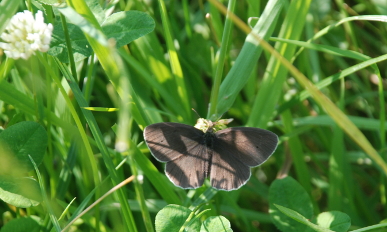 still calls despite the breeding season slipping away. Moorhens squabble on the river. Comma and Small Tortoiseshell butterflies flutter over the beds of nettles. A duck Mallard swims by followed by two ducklings. Up the hill past the old stone steps on the drovers trail. Yellow patches of bedstraw. Up the sunken trackway and out onto Eaton Hill. The farmer has sown a leafy vegetable on the field that has been used for maize over recent years. By the communications mast is a herd of young heifers sitting, ears flapping and tails swishing in a vain attempt to drive off the flies. They all rise and come to the gate to investigate Maddy and me. Down the track past Square-stalked St Johns Wort and Musk Mallows. Back past the Kenwater where yellow-centred white flowers of water Crowsfoot lay in the sparkling water.
still calls despite the breeding season slipping away. Moorhens squabble on the river. Comma and Small Tortoiseshell butterflies flutter over the beds of nettles. A duck Mallard swims by followed by two ducklings. Up the hill past the old stone steps on the drovers trail. Yellow patches of bedstraw. Up the sunken trackway and out onto Eaton Hill. The farmer has sown a leafy vegetable on the field that has been used for maize over recent years. By the communications mast is a herd of young heifers sitting, ears flapping and tails swishing in a vain attempt to drive off the flies. They all rise and come to the gate to investigate Maddy and me. Down the track past Square-stalked St Johns Wort and Musk Mallows. Back past the Kenwater where yellow-centred white flowers of water Crowsfoot lay in the sparkling water.
Thursday – Bodenham Lakes – Gentle rain falls. Boats are about to be launched from the yacht compound. A large flock of Canada Geese move across the water. Mallard, with the drakes in eclipse, are scattered over the lake. A Grey Heron stands on a low branch, a few inches above the water, on the far side. Four Cormorants are in the willows. Three Tufted Duck arrow across the lake at great speed before gliding down onto the water’s surface. A lone drake Gadwall crosses the lake. Purple Loosestrife stands high in red-purple spikes near the reed bed. Nearby, are the rich pink flower heads of Common Centaury. Back along the hedgerow an almost pure white moth, a Common White Wave, shelters on a bramble leaf. A Green Woodpecker circles a telegraph pole in the orchards before flying into one of the larger apple trees. A sheep uses the stake holding the chicken wire that protects an apple tree to reach up and nibble off apples from the lowest branches.
Sunday – Home – The garden is now yielding decent amounts of produce. Over the last couple of weeks we have had a fair amount of strawberries, blackcurrants and whitecurrants. Gooseberries were plentiful if a little small. The broad beans have finished, not as many as I would have liked but a few portions are in the freezer. Peas are producing well, but I rather overdid 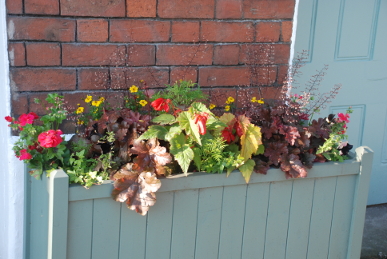 the sowing and they are a tangled mess. I have dug most of the potatoes, a pretty fair crop, Amarosa have done particularly well, the others less so, but as usual I have failed in the labelling in that they have all faded and I cannot read, or remember, what I planted. The garlic crop has been much better than recent years when most was lost to rot, but there is still some white fungus affecting some bulbs. The red onions were a failure again with just a few shallot sized specimens. Chillies are beginning to appear in the greenhouse. French beans are doing well, despite most of my dwarf varieties actually turning out to be climbers! Likewise, the runner beans are now at the top of the frames. Courgettes and squashes have been very slow to get going but leaves are developing nicely now. A row of spinach has bolted before it got six inches high, but lettuces sown as a catch crop between the bean poles are doing well. Yet again the birds are devastated the Gladstone apples despite the CDs hanging from the branches as scarers. In front of the house and the museum, Kay has a glorious display in the planters.
the sowing and they are a tangled mess. I have dug most of the potatoes, a pretty fair crop, Amarosa have done particularly well, the others less so, but as usual I have failed in the labelling in that they have all faded and I cannot read, or remember, what I planted. The garlic crop has been much better than recent years when most was lost to rot, but there is still some white fungus affecting some bulbs. The red onions were a failure again with just a few shallot sized specimens. Chillies are beginning to appear in the greenhouse. French beans are doing well, despite most of my dwarf varieties actually turning out to be climbers! Likewise, the runner beans are now at the top of the frames. Courgettes and squashes have been very slow to get going but leaves are developing nicely now. A row of spinach has bolted before it got six inches high, but lettuces sown as a catch crop between the bean poles are doing well. Yet again the birds are devastated the Gladstone apples despite the CDs hanging from the branches as scarers. In front of the house and the museum, Kay has a glorious display in the planters.
Monday – Croft – Bright sunshine filters through the dense green arbour. The paths are slick with mud. The pools in Fish Pool Valley are covered with pale green swirls of algae. Few birds are singing. The path ahead is ethereal as sunshine glows in the thin mist. A squirrel runs through the canopy creating a white noise of water droplets on the leaves below (I later think that the noise is technically called “pink”, not white). After chasing her ball down the steep hillside of 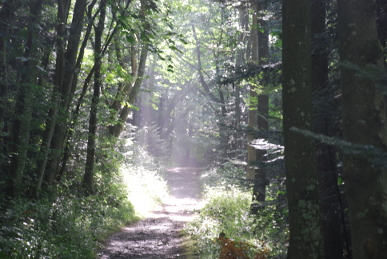 the Beech wood, Maddy takes to laying in muddy pools. Few flowers are in blossom, the most common being the Bramble. Great Tits and Chiffchaffs still call and there is a constant background hum of insects. Up the valley below Lyngham Vallet. A female Blackcap with a chestnut head searches the lower limbs of trees for food. Blue Tits churr, a Nuthatch calls from deep in the woods. The area at the top of Leinthall Common where the Bracken had been mown is now green again with fresh growth. Water-laden grasses and fronds of Bracken overhang the path and by the time I reach Croft Ambrey I am saturated. The South Shropshire hills are bathed in sunlight but the Welsh, Worcestershire and mid-Herefordshire hills are in a thin mist. Down near the castle a snapped-off stalk and head of a Stinkhorn fungus lies in the grass. A cow and her calf are alone in the field and the mother does not like Maddy passing by, and indeed the feeling is mutual.
the Beech wood, Maddy takes to laying in muddy pools. Few flowers are in blossom, the most common being the Bramble. Great Tits and Chiffchaffs still call and there is a constant background hum of insects. Up the valley below Lyngham Vallet. A female Blackcap with a chestnut head searches the lower limbs of trees for food. Blue Tits churr, a Nuthatch calls from deep in the woods. The area at the top of Leinthall Common where the Bracken had been mown is now green again with fresh growth. Water-laden grasses and fronds of Bracken overhang the path and by the time I reach Croft Ambrey I am saturated. The South Shropshire hills are bathed in sunlight but the Welsh, Worcestershire and mid-Herefordshire hills are in a thin mist. Down near the castle a snapped-off stalk and head of a Stinkhorn fungus lies in the grass. A cow and her calf are alone in the field and the mother does not like Maddy passing by, and indeed the feeling is mutual.
Wednesday – Bodenham Lakes – Columns of deep pink Rosebay Willowherb, called Fireweed or Bombweed from its propensity to grow on London bomb sites after the war (although the name Fireweed is commonly used in the USA), form a long line of colour at the back of the open area by the old gravel pit track. Evening Primrose rise in nearer the track along with assorted thistles, Teasels and Ragwort. Near the boat house is a greater profusion of yellows – many more Evening Primrose, Dark Mullein rising to five feet, Toadflax and St Johns Wort. White is represented by Hedge Bedstraw, Meadowsweet and Brambles, the latter also contributing to the pinks which includes Clover, Yarrow, Tufted Vetch and Mallows. A large flock of Canada Geese drift at the southern end of the lake. A Common Sandpiper bobs on the scrape. Mallard and Tufted Duck are scattered across the water. At the far end a Mute Swan leads four cygnets. There is a Barnacle Goose in the flock of Canada Geese. Cormorants sit on the platform with more in the trees. A couple of Grey Heron stand on the tip of the island.
Llantwit Major – We travel down in the afternoon to the coast of South Wales. There seems to be a surprising amount of traffic around the valleys and down beyond the M4 motorway. The town of Llantwit Major, Llantwit Fawr in Welsh, lies just inland of the Bristol Channel in South Wales. It is a few miles to the west of Cardiff and to the east of Bridgend. We are on a camp-site in the south-east of the town. We wander up a track beside a vast expanse of green wheat which separates us from the sea. There is no way through to the cliff tops from here so we return kicking Maddy’s disgustingly mucky ball ahead of us. Teasels grow in the hedgerow. Mayweed lines the edge of the field.
Thursday – Llantwit Major – Down a track by the camp-site entrance to Rosedew Farm. A track heads south then reduces to a path between wheat fields to the cliff tops. The strange heads of Salad Burnet, reddish spiky balls on a long, leafless stem, 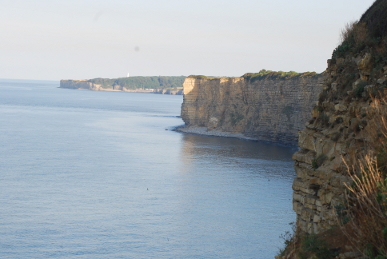 stand beside the path. The sky and sea are blue. The Somerset and Devon coasts, just a few miles over the Bristol Channel are hazy. Minehead, Lynmouth and the hills of Exmoor can be just made out. Linnets chatter on top of gorse bushes growing on the cliff top. This spot is between Pigeon Point and Stout Point. The latter sticks out into the sea, a cliff of strongly layered limestone. A Great Black-backed Gull sits on the sea. Small flocks of Swallows, House Martins, Sand Martins and the occasional Swift twitter as the fly along the face and tops of the cliffs. A Meadow Pipit stands on a rocky projection on the point looking up and down the cliff. A pair of Whitethroats churr gutturally on the gorse. Tankers ride at anchor on the far side of the channel. The strange square blocks of Hinkley Point nuclear power station lie in the distant east. Greater Knapweed’s purple contrasts with the rusty red of Dock against the green grasses. Large branched heads of Burdock are yet to flower. Back down to the farm. Pink Great Willowherb flowers adorn the edge of the track. All the old stone farm buildings have been converted into self-catering apartments. A Common Buzzard mews noisily from a Scots Pine, maybe a newly fledged bird awaiting breakfast from its parents. A Mistle Thrush rasps as it tussles with a Magpie over a field of black, black and and grey and white cows and calves.
stand beside the path. The sky and sea are blue. The Somerset and Devon coasts, just a few miles over the Bristol Channel are hazy. Minehead, Lynmouth and the hills of Exmoor can be just made out. Linnets chatter on top of gorse bushes growing on the cliff top. This spot is between Pigeon Point and Stout Point. The latter sticks out into the sea, a cliff of strongly layered limestone. A Great Black-backed Gull sits on the sea. Small flocks of Swallows, House Martins, Sand Martins and the occasional Swift twitter as the fly along the face and tops of the cliffs. A Meadow Pipit stands on a rocky projection on the point looking up and down the cliff. A pair of Whitethroats churr gutturally on the gorse. Tankers ride at anchor on the far side of the channel. The strange square blocks of Hinkley Point nuclear power station lie in the distant east. Greater Knapweed’s purple contrasts with the rusty red of Dock against the green grasses. Large branched heads of Burdock are yet to flower. Back down to the farm. Pink Great Willowherb flowers adorn the edge of the track. All the old stone farm buildings have been converted into self-catering apartments. A Common Buzzard mews noisily from a Scots Pine, maybe a newly fledged bird awaiting breakfast from its parents. A Mistle Thrush rasps as it tussles with a Magpie over a field of black, black and and grey and white cows and calves.
Boverton – A village on the east side of Llantwit Major. A large ruined manor house, Boverton Place stands by a meadow. Adjoining buildings have been converted into a home. The manor was established by Robert Fitzhamon for the Steward of the Manor. The house was rebuilt in 1597-98 by Roger Seys. The house became the property of Robert 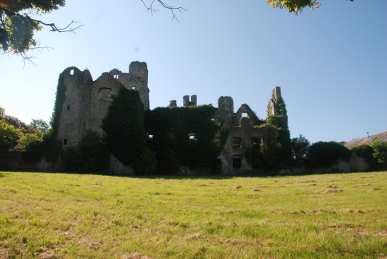 Jones of Fonmon when he married the heiress to Boverton, Jane Seys and she died without producing an heir. The house was abandoned and fell into ruin. The walls and towers of the manor are in the pale limestone of the area. Jackdaws perch atop the crenellations. About a mile down a narrow road that turns into a track is Summerhouse Point. The Summerhouse was built in around 1730 by the Seys family. The Summerhouse is octagonal and set within an octagonal enclosure. The adjoining cottage was occupied by the caretaker and the building was still inhabited in the 1920s. What is there now is unclear as notices make it clear that no visitors are welcomed. Surrounding the Summerhouse is an Iron Age fort dated 700BCE to 100CE. The fort has several ramparts and is semi-circular with the sheer sea cliff on the South side. A path leads past the ramparts to a Lookout and Seawatch tower. Unfortunately it is closed. Herb Agrimony, a localised plant, is growing profusely. We find a viewpoint where the thick cliff top bushes have thinned to leave a space. The Somerset coast is hazier than earlier this morning. A domed caisson stands off Breaksea Point. Looking like a sea-fort, it is actually the cold water inlet for Aberthaw power station which stands just inland dominating the view. Back down the path. A Chiffchaff searches the stumpy trees. A Greenfinch perches on wires.
Jones of Fonmon when he married the heiress to Boverton, Jane Seys and she died without producing an heir. The house was abandoned and fell into ruin. The walls and towers of the manor are in the pale limestone of the area. Jackdaws perch atop the crenellations. About a mile down a narrow road that turns into a track is Summerhouse Point. The Summerhouse was built in around 1730 by the Seys family. The Summerhouse is octagonal and set within an octagonal enclosure. The adjoining cottage was occupied by the caretaker and the building was still inhabited in the 1920s. What is there now is unclear as notices make it clear that no visitors are welcomed. Surrounding the Summerhouse is an Iron Age fort dated 700BCE to 100CE. The fort has several ramparts and is semi-circular with the sheer sea cliff on the South side. A path leads past the ramparts to a Lookout and Seawatch tower. Unfortunately it is closed. Herb Agrimony, a localised plant, is growing profusely. We find a viewpoint where the thick cliff top bushes have thinned to leave a space. The Somerset coast is hazier than earlier this morning. A domed caisson stands off Breaksea Point. Looking like a sea-fort, it is actually the cold water inlet for Aberthaw power station which stands just inland dominating the view. Back down the path. A Chiffchaff searches the stumpy trees. A Greenfinch perches on wires.
Llantwit Major – We head first of all to the beach. It lies at the end of a long valley of meadows called Cwm Col-huw. A stream, Afon Col-huw runs through and out onto the rocky coast. The valley was carved out some 15,000 years ago when melting glaciers resulted in what is now a gentle stream to be a raging torrent, Up onto the eastern cliff. A Fulmar glides along the cliff top. I rather naughtily peep under black corrugated squares laid by naturalists. Under one is a Slow Worm. Across an open area and up onto a rampart, the first of two called Castle Ditches. These are the ramparts of an Iron Age promontory fort. It is thought the original entrance has been lost to cliff erosion. Sea Cabbage grows on the cliff top. We return to the town centre and visit the church of St Illtud. The saint was probably a Breton who, according to the book “The Life of St Sampson of Dol” written around 610, was ordained by Garmon of Auxerre around 455. Illtud settled in Llantwit Major in about 500, possibly as a hermit. He attracted a substantial following and established a monastery, school and church here. The town of Llantwit takes its name from the site, Llan meaning church enclosure twit being a corruption of Illtud. The land was given to Robert Fitzhamon after the Conquest. He kept the area as his own growing grain to feed his garrison in Cardiff. The church and its tithes were given 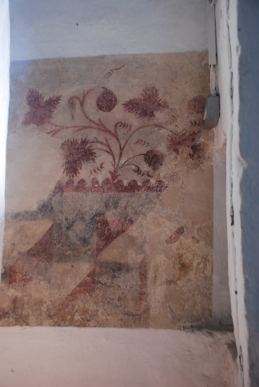 to an abbey Fitzhamon founded at Tewkesbury.
to an abbey Fitzhamon founded at Tewkesbury.
The Celtic church was rebuilt around 1100 as what is now the west church. The east church, now the chancel and nave, was built in the 13th century. After the Dissolution, the revenues passed to Gloucester cathedral and did not return until the Disestablishment of the Welsh Church in 1920. The entrance is through a porch built in the 13th century. Along the top of its walls are wooden carvings of animals and a long inscription. There is a splendid collection of Celtic stones at the western end, including the 1.9 metre high Houelt Cross with an inscription referring to Houelt, son of Res, probably Hywel ap Rhys, King of Glywysing (the land between the rivers Tawe and Usk) in the 9th century; the St Illtud or Samson cross with the inscription which translates as “Samson placed his cross; for his soul; for the soul of Illtud, Samson the king, Samuel, Ebisar”; the Pillar of Samson, also inscribed mentioning Iuthahelo, believed to be Ithel, king of Gwent who died in 846 and a smaller pillar. On the floor is the old curfew bell cast in Gloucester in 1320. Two effigies lie in the west church. The southern one dates from the 13th century and has the carving of a tonsured head. The inscription in Lombardic capitals translates as “Let not the stone be trodden on: let her who lies beneath be protected”. The effigy on the north side is also for a woman, this one being a lady in Elizabethan dress. At her shoulder is a small child which suggests she may have died in childbirth. She is thought to be Joan, wife of the Steward of the Manor, Richard Hopkins. She died around 1580. The east church gable shows where the roof has been raised twice. This extra weight has pushed the arches of the southern aisle outwards at the top by over a foot. Flying buttresses were added in 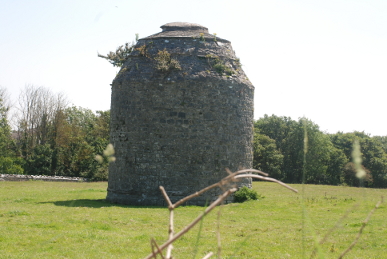 1905 to support them. The chancel arch has a hatched pattern wall painting on which is a modern rood designed by Alan Durst and mounted in 1959. Previously a hatchment commemorating Revd Robert Nicholl Carne who died in 1849 hung here. The reredos behind the high altar is in carved stone with twenty two niches for saints but these were destroyed by the Puritans. The font is Norman and carved from Sutton stone. On the walls are a number of wall paintings including St Christopher, the Stuart coat of arms with the inscription “God Save King James 1604”, one of Mary Magdalene and a number of other painted panels. Most of these had all been covered in whitewash since the Order in Council of 1547 and renovated in 1950 and restored in 1992. On the far south side of the graveyard is the ruined building which was a house for the chantry priest. He said prayers each day for the souls of the dead, especially the Raglan family who had endowed a chapel beyond the western end of the church called Galilee Chapel. This is now in ruins. Up the hill to the west stands the gatehouse of the abbey grange or farm. Opposite was the old tithe barn and beyond, in Great Ley Field is a mediaeval dovecot.
1905 to support them. The chancel arch has a hatched pattern wall painting on which is a modern rood designed by Alan Durst and mounted in 1959. Previously a hatchment commemorating Revd Robert Nicholl Carne who died in 1849 hung here. The reredos behind the high altar is in carved stone with twenty two niches for saints but these were destroyed by the Puritans. The font is Norman and carved from Sutton stone. On the walls are a number of wall paintings including St Christopher, the Stuart coat of arms with the inscription “God Save King James 1604”, one of Mary Magdalene and a number of other painted panels. Most of these had all been covered in whitewash since the Order in Council of 1547 and renovated in 1950 and restored in 1992. On the far south side of the graveyard is the ruined building which was a house for the chantry priest. He said prayers each day for the souls of the dead, especially the Raglan family who had endowed a chapel beyond the western end of the church called Galilee Chapel. This is now in ruins. Up the hill to the west stands the gatehouse of the abbey grange or farm. Opposite was the old tithe barn and beyond, in Great Ley Field is a mediaeval dovecot.
We return to the town which grew in wealth in the 16th century through sheep. Some large houses demonstrating this wealth still stand in the town, Great House, Court House and Plymouth House, the last being built from part of a halled residence of the 15th century. The Town Hall is often attributed to Gilbert de Clare, Lord of Glamorgan, who died in 1295, but manorial records suggest it is more likely to be 15th century build. We have lunch in The Old Swan, allegedly built in the 12th century, but more likely to be 16th century and said to be the oldest pub in the town, although yet again when it actually became an inn is unclear. Kay visits the local butcher who has a tale of woe about the lack of trade these days. A large shopping centre has been built in the centre of the town. It is dominated by a Co-op supermarket. Otherwise the shops are the usual mix of charity and cheap shops, no proper grocer or greengrocer.
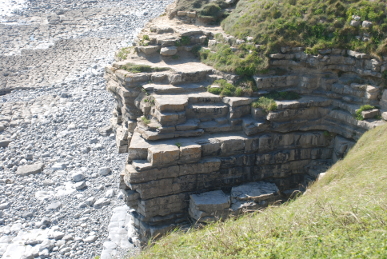
In the late afternoon we stroll down to the cliff tops. Three Kestrels hang over the edge like three flying duck ornaments on a blue wall. Near Stout Point is New Way Steps. The limestone fractures into slabs which, probably with the assistance of human hands and tools, has created a series of ledges that can be used as steps down to the beach. Linnets sit and twitter on the gorse. A large clump of Burdock nearly blocks the path. Along the coast westwards people are on the beach where we were this morning. Further west is St Donats castle. Built in 12th century, it was restored by John Nicholl Carne, then Morgan Williams. The estate was bought by William Randolph Hearst, the newspaper tycoon in 1925. In 1937 it was proposed that our Grange House in Leominster was to be sold to Hearst, who was to demolish it and rebuild it here at St Donats. Fortunately the town council prevented this. A number of thistles have succumbed to blackfly infestation. There are ripe Blackberries in the hedgerows. Bryony climbs the Hawthorn hedge, its leaves shine as though they had been freshly varnished. Back up the track from Rosedew Farm. Maddy rolls on the track, coating herself with dust making her two shades of grey.
Friday – Llantwit Major – A cloudier morning. A Skylark sings high over the ripening wheat. The Kestrels are over the cliff top. A Fulmar flies along the face of the cliff. The coast opposite is just a shadow in mist. A female Peregrine Falcon flies by. The sea is flat, the sound of waves can be heard from below. The tankers that were at anchor up the channel yesterday have moved on. Linnets, Meadow Pipits and Whitethroats flit across the cliff top shrubbery, diving inside to search for food. House Martins, Swallows and Swifts sweep along the cliffs with forays inland to pass over the wheat field. Fulmars squawk on ledges near Pigeon Point, dropping off to soar out across the sea. The occasional gull flaps by. A screen of Blackthorn runs along the cliff edge. There are a few patches where sloes hang thickly but most of the bushes are just leaf.
Saturday – Home – The chickens have been problematic over the last week. I was cleaning out the chicken house last Wednesday when I noticed I was itching. I was crawling with Red Mites! A retreat to the bathroom where my clothes were dumped into very hot water and I dived into the shower. Having got my clothes into a hot cycle on the washing machine and quite sure there were none of the blighters left on me, I headed off to Dinmore and bought some chemical to deal with the infestation. I sprayed the chicken house on Wednesday and again today. As far as I can tell, they have been dealt with, but I think I will spray again in a week or so. There was a softish, broken egg in the nest box this morning as well as the little new girl’s regular daily egg. I think Ginger may be laying again and it may be that she is feeling happier not being bitten by mites! All the potatoes have been dug now. Amorosa, a red potato have done reasonably well, as has Ambro, a pretty cream and red potato. Sharpe’s Express have not been so successful, a decent number but really quite small tubers. The Climbing French Beans and Runner Beans have all reached the top of the bamboo framework and flowers are appearing. There are small beans on the Dwarf French Beans. Tiny courgettes are appearing. Radishes and Pak Choi have sprouted well and today’s sunshine and showers should help!
Monday – Bodenham Lakes – A strong south-westerly blows grey, rain-laden clouds across the sky. Five Cormorants stand on the pontoon,one fishes and many more are in the trees. Waterfowl are mainly gathered in the lea of the wind, behind the island or at the far southern end of the lake. A large group of Mallard are near the channel between the lakes. The sun makes brief appearances. Behind the hide, hoverflies are stationary beside Ragwort. A Gatekeeper butterfly flits down the path. Early apples are just edible now. Irish Peach are still slightly sharp but good and juicy. Worcester Pearman, which are the commonest early apple are much too sour still.
Tuesday – Credenhill – Luminous grey clouds cover the sky. It seemed cool until I had slogged up the hill by which time I was close to steaming. It seems strange that in the height of summer so few flowers are in blossom. Apart from a few yellow St Johns Wort, purples and pinks dominate – late Foxgloves, Willowherbs, thistles and brambles. A Chiffchaff calls, surely too late to be worried about his territory. A Carrion Crow caws in the distance and a Wren sounds the alarm nearby. Out of the rows of conifers and onto the cleared area of the vast Iron Age fort. A Raven honks. Down to the east gate and up onto the massive ramparts. A cat dashes off into the woods, a long way from home I would guess. Standing here looking at the deep ditch between this rampart and the next down the hill, one must marvel at the amount of work these Iron Age people undertook to build this fort using only rudimentary tools. I imagine it would takes a considerable time with modern machinery. They used the lay of the land well but this does not diminish the massive undertaking. Maddy drops her 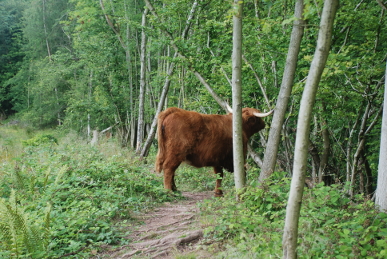 ball at the top of the slope and has to chase after it as it rolls off down towards the ditch. She casts a sideways glance at me as she returns, “Did he notice?” There have been articles published recently about dog behaviour and training. César Millán, the “Dog Whisperer”, seems out of favour although we found his programmes on television very encouraging and helpful as we struggled with Maddy’s difficult behaviour. Many say that ascribing human characteristics to dogs’ facial expressions is wrong, but seeing the sometimes sly, sometimes worried look on Maddy’s face when she has done something wrong but yet unnoticed by us, makes me wonder. It is peaceful here, sitting on a stump, the wind rustling the leaves, Wood Pigeons cooing and the occasional other avian squeak or whistle. A few Meadow Brown butterflies flit through the sedges that grow abundantly on the cleared ground. A Small White settles on a nettle despite being buffeted by the wind. A Peacock rests on a piece of wood in the sun along with a dozen black flies. Below the rampart, inside the fort on the western side are a couple of red longhorn Highland cattle. They ignore us and keep feeding. However, a third is on the path ahead of us. I drive her along the path hoping she will turn off. She moves her head delicately as she moves through the saplings and trees to avoid her horns touching the trunks. Eventually she moves to one side and we can pass.
ball at the top of the slope and has to chase after it as it rolls off down towards the ditch. She casts a sideways glance at me as she returns, “Did he notice?” There have been articles published recently about dog behaviour and training. César Millán, the “Dog Whisperer”, seems out of favour although we found his programmes on television very encouraging and helpful as we struggled with Maddy’s difficult behaviour. Many say that ascribing human characteristics to dogs’ facial expressions is wrong, but seeing the sometimes sly, sometimes worried look on Maddy’s face when she has done something wrong but yet unnoticed by us, makes me wonder. It is peaceful here, sitting on a stump, the wind rustling the leaves, Wood Pigeons cooing and the occasional other avian squeak or whistle. A few Meadow Brown butterflies flit through the sedges that grow abundantly on the cleared ground. A Small White settles on a nettle despite being buffeted by the wind. A Peacock rests on a piece of wood in the sun along with a dozen black flies. Below the rampart, inside the fort on the western side are a couple of red longhorn Highland cattle. They ignore us and keep feeding. However, a third is on the path ahead of us. I drive her along the path hoping she will turn off. She moves her head delicately as she moves through the saplings and trees to avoid her horns touching the trunks. Eventually she moves to one side and we can pass.
Friday – Mortimer Forest – It starts to rain as I leave the car park. The woods are quiet, a Carrion Crow caws loudly and a Robin ticks a warning. Pink and white flash as a Jay slips away over the trees. The rain washes dust off the leaves leaving them shining like new. The pond at the top of the valley is reduced to a puddle. Common Buzzards mew from a distance, another calls more sharply from the Deer Park woods. The edges of the tracks are covered in lime-green Coltsfoot leaves, once dried and smoked like tobacco. A Yellowhammer sings “A little bit of bread and no cheeeeese” from the top of a young Larch. Up towards High Vinnalls where huge candle-like cones rise on Larch branches. Angelica grows tall on purple stems. Tiger-striped caterpillars of the Cinnabar moth feed on Ragwort. The hills are hazy. Fields below are a patchwork of greens and tan yellows. What I have always assumed was a hunting lookout on the top of High Vinnalls is, apparently an old radio relay hut. A small patch of Harebells flower on the bank of the Iron Age enclosure. The sun is out and it has almost stopped raining. The last of the Foxgloves with a few flowers at the top of long browning stems are dotted around the enclosure’s interior. Thistles and Rosebay Willowherbs compliment the Foxgloves’ pinks. Small chocolate brown “heads” grow on the stems of rushes. A strangled horn and a distant thrum mark the passing of a freight train in the valley below.
Monday – Bodenham Lakes – Hot sunshine in a blue sky with a scattering of high cirrus cloud. A cock crows, Wood Pigeons coo, Great Spotted Woodpecker chips and small birds squeak and chatter – an English summer morning. Flowers seem to have given their best and are now exhausted. St Johns Wort droops, Evening Primrose and Willowherbs have flowers only at their tips now but Teasel is only now coating its prickly heads in purple. A small skein of Canada Geese flies noisily overhead. Large fish , possibly Carp, are thrashing on the surface between rafts of yellow-green algae. A Grey Heron flies off from the far side of the lake. Our perambulation along the meadow disturbs a Common Buzzard which flies off and up into the woods. A pair of Carrion Crows search the water’s edge on the scrape for food. A large flock of Canada Geese glide very slowly and, surprisingly quietly, from behind the island. The Grey Heron stands hunched on a spit off the island. Cormorants stand on the pontoon, one a juvenile with white underparts. Another is fishing near the scrape. A Mute Swan with three cygnets is at the south end of the lake. Another flock of Canada Geese is at this end too. Occasionally a small number of geese will leave the main flock and with much honking go and join the other. Four Coot dive in the middle of the water. A donkey with a net on its head I suppose to keep off flies, browses in the field next to the hide. I scrump a few apples from the orchard – Irish Peach, Worcester Pearmain and Jubilee. The first is in perfect condition but the latter two are still a bit sharp and Jubilee is rather bland.
Wednesday – Dinmore – A track heads south from the entrance to the country park, on the other side of the busy A49. I tried this track some time ago but the mud and deep water-filled ruts defeated me. Today it should be dry given the lack of rain recently. Sun filters through the canopy onto dense undergrowth of bracken and brambles. A Robin sings. The old air tower stands crowned with rusting scaffolding. Numerous Great Tits are scurrying up the walls searching for food in the cracks in the stonework. A Great Spotted Woodpecker joins them. Pink Herb Robert bloom beside the path but most other flowers have turned to seed. The trees are dominated by Ash, but a good selection of other species are here, Horse and Sweet Chestnut, Field Maple, a few conifers and Oak. All of the trees I would guess at less than a century old. The path is in danger of disappearing into the undergrowth. Brambles try to bar my way, pulling at my clothes, Stinging Nettles caress my arms whilst the tiny needles on their leaves inject their cocktail of formic acid and histamine. The path reaches a well defined track and another path, recently cut back, continues south-easterly. However, it twists and turns and eventually recrosses the track. I take the track which is more in the direction I wish to travel. Jays squawk, a Raven barks as it flies over. Chaffinches flit from tree top to tree top. The mass of Ivy climbing up an Ash conceals small birds which set leaves quivering. Occasionally a brief glimpse of a Blue Tit or Chiffchaff is seen. The track leaves the wood and crosses the top of the hill towards Hen House farm. To the north lies the valley of the River Lugg. Hampton Court is hidden below the hill, the slope of which is named “Ashen Grove”. A tractor pulling a trailer of bales of straw descends the far hillside, Hampton Park, in a cloud of dust.
The area here is an Iron Age site examined last year by the Time Team. It is a massive area although few remains were uncovered. The name “Dinmore”comes from the Welsh, “Din” and “Mawr” meaning “Big Fortress”. Back up the track. Gatekeepers feed on Upright Hedge Parsley . Oaks have been planted alongside the track, maybe twenty or thirty years ago. An old Oak in the field has bunches 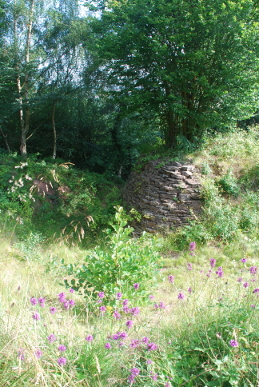 of leaves on mainly dead branches. There are older Oaks in the avenue along the track- some possibly a century old, others older still. It looks like there has been three separate plantings over several hundred years, a wonderful example of continuity. Green Woodpeckers are calling and flying between the Oaks. Two tall Wellingtonia – Redwoods – stand at the edge of the wood. Another recently mown path heads off into the trees and I follow into Holly Bush Plantation. The path exits the woods on the northern side of the field from Hen House. There is a steep old track that curves down the hillside around a stone built buttress. The top of this bank between my path and the sunken roadway is covered in purple Betony. I return along the mown path with continues in the opposite direction along the edge of a steep hill. The path becomes a broad track, not often used as evidenced by the fallen branches blocking it. A Mistle Thrush flies off and a Wren ticks in warning. A Green Woodpecker yaffles nearby. Large prints have churned the mud but not horses, they are cloven. They must be cattle but where are they going? The track abruptly ends in a thicket of fallen branches and nettles. I find the vestiges of a path that heads in the same direction several yards away. This is more of an illusion than a path and brambles are soon tugging at my ankles. I find the track again, now sunken by several feet and still very overgrown. It emerges onto the A49 near Maythorne Cottage. We cross the road and both Maddy and I jump out of our skins when a military jet roars over just above the trees. A short way down Dinmore Hill, a footpath leads down into Hope under Dinmore. Through the village and up into the country park.
of leaves on mainly dead branches. There are older Oaks in the avenue along the track- some possibly a century old, others older still. It looks like there has been three separate plantings over several hundred years, a wonderful example of continuity. Green Woodpeckers are calling and flying between the Oaks. Two tall Wellingtonia – Redwoods – stand at the edge of the wood. Another recently mown path heads off into the trees and I follow into Holly Bush Plantation. The path exits the woods on the northern side of the field from Hen House. There is a steep old track that curves down the hillside around a stone built buttress. The top of this bank between my path and the sunken roadway is covered in purple Betony. I return along the mown path with continues in the opposite direction along the edge of a steep hill. The path becomes a broad track, not often used as evidenced by the fallen branches blocking it. A Mistle Thrush flies off and a Wren ticks in warning. A Green Woodpecker yaffles nearby. Large prints have churned the mud but not horses, they are cloven. They must be cattle but where are they going? The track abruptly ends in a thicket of fallen branches and nettles. I find the vestiges of a path that heads in the same direction several yards away. This is more of an illusion than a path and brambles are soon tugging at my ankles. I find the track again, now sunken by several feet and still very overgrown. It emerges onto the A49 near Maythorne Cottage. We cross the road and both Maddy and I jump out of our skins when a military jet roars over just above the trees. A short way down Dinmore Hill, a footpath leads down into Hope under Dinmore. Through the village and up into the country park.
Friday – Croft – It is raining steadily as I head down into Fish Pool Valley. Yet again, an unreliable forecast which stated there may be a shower or two, but it has now been raining since the early hours. Not that I am complaining, the garden desperately needed this. The woods are silently apart from the noise of raindrops on leaves. Up the path towards the Keeper’s Cottage from the old lime kiln and quarry. It has not taken long for the path to turn to mud. Stinging Nettles, heavy with rain water, lean across the path and bramble runners emerge from thickets seeking new territory. It is easy to see how a path can get quickly overgrown but a few swishes with my stick knock back the invaders. The Spanish Chestnut field seems to be covered in white blossom, but it is rainwater in the feathery heads of grasses. Swallows twitter excitedly as they swoop over the farm buildings beside the castle. On the way back down the lanes towards Bicton more groups of Swallows are gathered on wires and nearby bushes.
Home – We have now had the first courgette and first French beans. The peas are still producing and new rows have been sown. Blueberries are prolific as are the berries we think may be Tayberries. The Shropshire Prune damson has a decent amount of fruit but much of it is over the wall, so I cut off the branches so we can develop them on our side. I have also pruned the Gladstone apple tree quite severely. I am at a bit of a loss to know what to do about this tree, every year the birds eat the apples before they are ready and we get no crop at all. CDs on string did no good as they last couple of fruit were pecked out leaving us nothing. In the greenhouse, chillies and capsicums are heavy with peppers. Yet again the green chillies are very mild, hopefully they will develop some heat when they ripen. The Runner beans are covered in flower but the Climbing French beans look like they are more leaf than flower. I think the beans had cross-pollinated last year and they are no longer such prolific strains. It will probably be a good idea to start with new seed all round next year, which is a pity as they are all heritage varieties. Of course, I may be wrong and they will flower more heavily now they have had a good soaking from the rain.